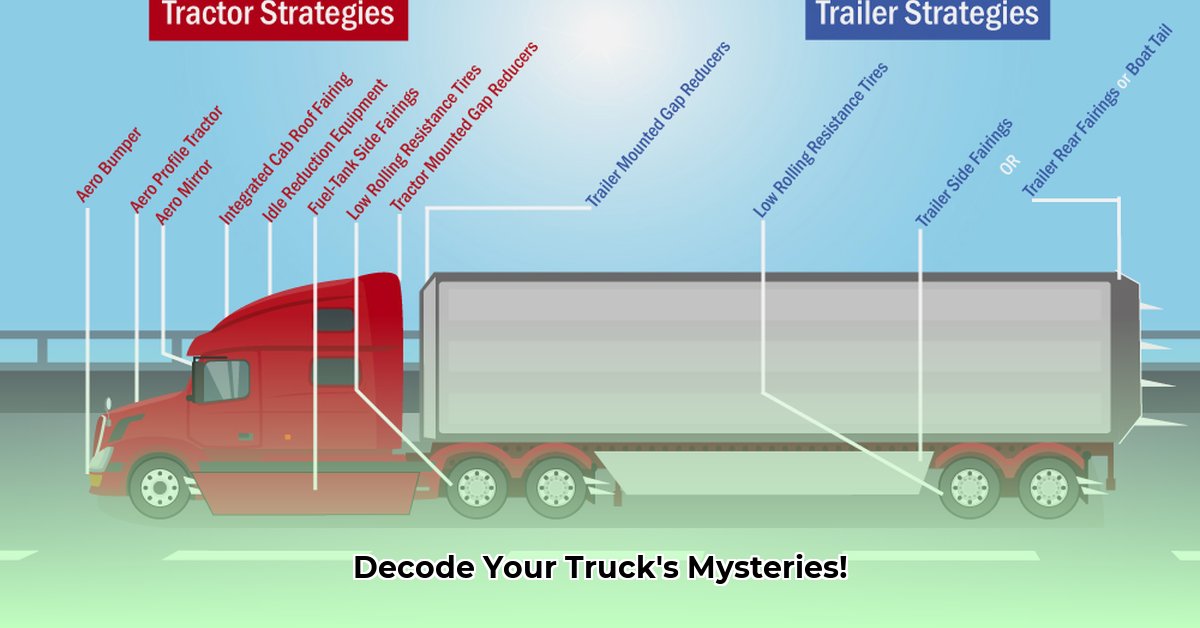
Understanding the components of a tractor-trailer is crucial for drivers, mechanics, and anyone interested in the logistics industry. This guide provides a comprehensive overview, using a clear diagram and detailed explanations to illustrate the key parts of both the tractor unit and the trailer unit. For more on trailer suspension, check out this helpful resource: leaf spring info.
Tractor Unit: The Powerhouse
The tractor unit is the driving force behind the operation, housing the engine and controls. Let's explore its key components:
Engine (Diesel Engine): The powerful heart of the tractor, providing the force to haul heavy loads. This is typically a large diesel engine providing significant horsepower.
Transmission (Gearbox): This system transfers power from the engine to the wheels, allowing for gear changes to manage speed and power output. Manual, automated manual, and automatic transmissions are common.
Cab (Driver's Compartment): The driver's workspace, containing controls, gauges, and safety features for a comfortable and safe driving experience. Driver comfort is essential for long hauls.
Axles (Wheel Support): Sturdy bars connecting the wheels to the frame. The front axle steers; rear axles support the weight. The number of axles affects weight capacity.
Suspension (Shock Absorption): A system of springs and shock absorbers that smooths out the ride and protects the chassis from road shocks. It's crucial for both cargo and driver safety.
Fuel Tanks (Diesel Storage): Large tanks holding substantial amounts of diesel fuel, enabling long-distance travel. Fuel efficiency is a key factor in operational costs.
Exhaust System (Emission Control): This system routes exhaust fumes away from the cab while minimizing environmental impact via emissions control devices. Regulations regarding emissions are rigorously enforced.
Fifth Wheel (Tractor-Trailer Coupling): The critical point connecting the tractor to the trailer, enabling the combined unit to operate. Secure coupling is paramount for safety.
Brakes (Stopping System): Crucial for safe operation, usually air brakes providing significant stopping power for heavy loads. Regular brake maintenance is non-negotiable.
Steering System (Vehicle Guidance): Allows the driver to control the direction of the tractor, often aided by power steering for easier handling. Proper steering is critical for safe maneuvering.
Do you know what percentage of accidents involving tractor-trailers are attributed to brake failure? Studies show that a significant portion of these accidents are directly linked to brake malfunction.
Trailer Unit: The Cargo Carrier
The trailer is the cargo-carrying section. Here are its essential parts:
Landing Gear (Trailer Support): Retractable legs that support the trailer when disconnected from the tractor, allowing it to stand independently. This is crucial for loading and unloading.
Kingpin (Trailer Connection): A large pin that fits into the tractor's fifth wheel, ensuring the secure connection between the tractor and trailer. Proper kingpin alignment is essential.
Chassis (Trailer Frame): The main structural framework supporting the cargo bed and other components. Its strength and durability are vital for stability.
Axles (Weight Distribution): Axles connect the wheels to the chassis, distributing the weight of the cargo. Multiple axles improve stability and weight distribution.
Suspension (Cargo Protection): Similar to the tractor's suspension, this system absorbs shocks, protecting both the cargo and the trailer itself. Effective suspension reduces cargo damage.
Wheels and Tires (Ground Contact): Heavy-duty wheels and tires supporting the weight of the cargo and providing traction. Proper tire inflation is critical for safety and fuel efficiency.
Brakes (Trailer Stopping): Air brakes working in conjunction with the tractor's brakes for coordinated stopping. This ensures safe and controlled braking of the entire unit.
Cargo Area (Goods Storage): The compartment where the goods are stored; designs vary depending on the type of cargo (e.g., dry van, flatbed, reefer). Proper cargo securing is paramount.
Did you know that the average tractor-trailer can carry up to 80,000 pounds of cargo? This highlights the immense weight-bearing capacity of these vehicles.
Tractor vs. Trailer: A Comparison
| Feature | Tractor Unit | Trailer Unit |
|---|---|---|
| Primary Function | Propulsion and Steering | Cargo Transportation |
| Power Source | Internal Combustion Engine | None; relies on tractor |
| Driver's Area | Integrated Cab | None |
| Axles | Typically 2 or more | Typically 2 or more; depends on cargo weight |
| Braking System | Independent, linked to trailer brakes | Dependent on tractor brake system |
| Suspension System | Shock absorption, driver comfort | Shock absorption, cargo protection |
"The synergy between the tractor and trailer is crucial for efficient and safe transportation," explains Dr. Emily Carter, Professor of Mechanical Engineering at MIT. "Understanding their individual roles emphasizes the importance of proper maintenance and operation of both components."
This detailed guide provides a fundamental understanding of the major components. Further research may be needed to fully grasp the intricacies of specific systems. Remember, the safety and efficiency of these vehicles rely on the proper functioning of all parts.